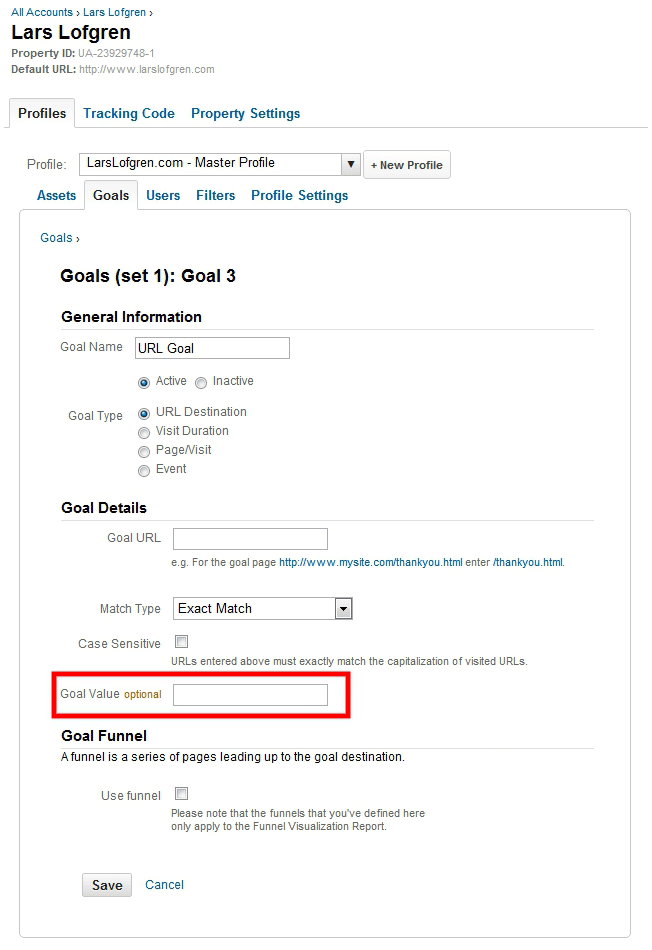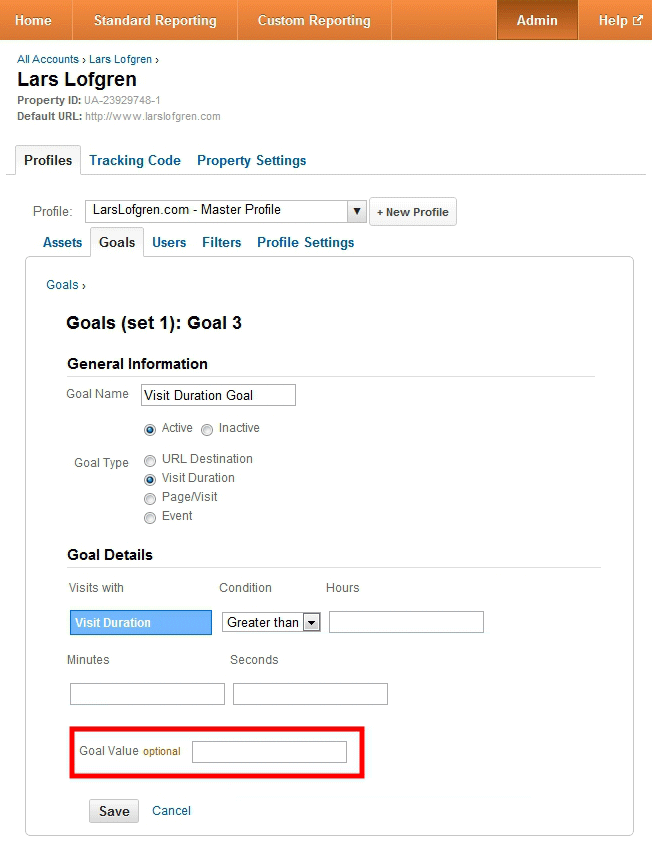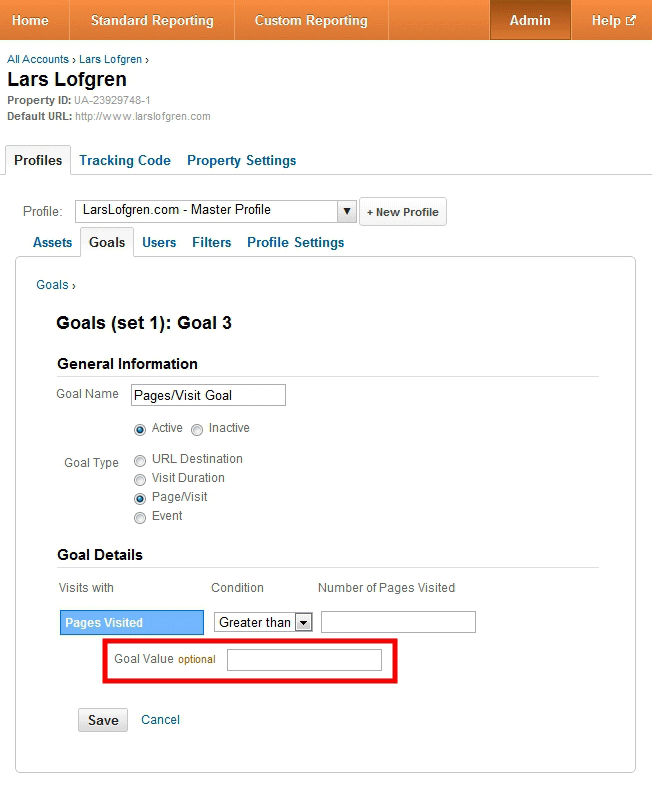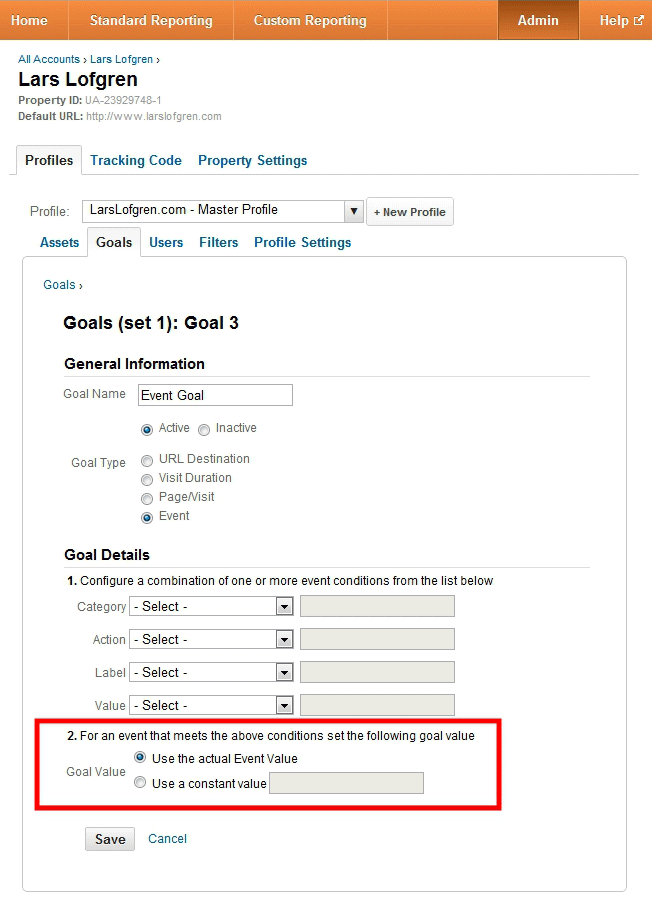Wouldn’t you like to know how much money you make from organic search? Or your marketing campaigns? Google Analytics Goals do a great job at telling you where customers came from but they don’t immediately tell you how much money you actually made.
Google Analytics has one little setting that will calculate all of this for you. You’ll be able to break down your revenue by campaign, keyword, or referral. You’ll even have the per visit value of every traffic source. That sounds like some delicious data if you ask me.
It’s called goal values. Google Analytics allows us to define goal values for each of our goals and populates our reports with data on where our revenue is coming from.
How to Setup Goal Values
This is pretty straightforward:
- Go to your Google Analytics standard reports
- Click on the “Admin” button in the top right
- Click on “Goals”
- From one of the Goal sets, click “+ Goal” (goal sets are just a way for you to easily group goals) if you’re setting up a new goal. For a goal you’ve already created, click on the goal you want to edit.
For each goal type, you have the option of entering a goal value. If the goal value is $10, simply punch in 10 and Google Analytics will handle the rest.
Here’s where to find the Goal Value setting for each type of event:
URL Goals
Visit Duration
Pages/Visit
Events
On events, you can choose to have the Goal Value use the Event Value, which you define when you create the event. For the lowdown on events and how to set them up, check out Google’s Event Tracking Guide.
If you’re having trouble finding the Event Goals, make sure you’re in the new version of Google Analytics (v5). Events Goals are a new feature and weren’t available in prior versions.
Always Use Ecommerce Tracking First
Goal values are not a substitute for ecommerce tracking in Google Analytics. So if you have an ecommerce site, don’t try to use use goals values to track revenue. Your ecommerce reports give you much better insights on your products, transactions, and how long it takes your customers to purchase. Seriously, these reports are a goldmine. You can practically mint money with this data.
And if you already have ecommerce tracking set up, there’s no reason to use goal values (or goals) for your transactions. Google Analytics does all the work for you.
If you have an ecommerce site, take the time and get ecommerce tracking set up. Go to Upwork and find someone to do this for you.
Single Product Websites (The One Exception)
There’s one situation where it makes sense to ignore my recommendation to use ecommerce tracking over goal values. And that’s if you have a single product website. But for this to work, your site must truly have a single product. You can’t have alternate versions or upsells. One product, one SKU, one price.
In fact, I actually recommend doing this if you’re testing a new product. In this case, you’re not even sure if your idea is going to work. So don’t invest any more money that you absolutely have to. Instead of paying a developer in India to set up ecommerce tracking, just punch in the goal value and find out if you can actually make money. Keep it simple when you’re just starting. Then spend the money on getting ecommerce tracking enabled once you’re committed to your new business model.
If this is the case, take the price of your product and use it as the goal value.
The Most Popular Use for Goal Values: Leads
Leads are perfect for goal values. There’s no purchase so ecommerce tracking isn’t an option. And since leads are generally easy to quantify, let’s bust out those goal values.
To figure out your goal value for a lead, work backwards.
Let’s use a travel agency in Southeast Asia as an example. They received 10 leads during the month which produced $12,500 in revenue. Take the total revenue ($12,500) and divide it by the number of leads (10) which means each lead is worth $1,250. That’s the goal value.
Now, this example assumes that ALL their leads came from their site. Your sales funnel is probably a bit more complicated. When calculating your total revenue and the number of leads you received, don’t include leads that come from any other source like word-of-mouth referrals, social media, affiliates, etc. This keeps your data as clean as possible so you can make better business decisions later.
If you have multiple ways for people to become a lead on your site (like a newsletter and a contact form), separate the data you have on your leads and calculate goal values for each.
When calculating your revenue and leads, use data from the past month or quarter.
Bonus Point Round: If you want your goal values to be as accurate as possible, there’s another step.
Instead of calculating the goal value based on the average value of the first order, you calculate it using the average Lifetime Value (LTV) of your customers.
Most businesses have repeat customers. And lifetime value is the total amount that customers spend on your products or services before they move on. This data isn’t easy to track, you’ll need a solid customer database. Talk to your finance and IT teams about tracking lifetime value, they’ll be able to point you in the right direction. If you’re small enough that you don’t have finance and IT teams, just worry about the first sale.
Other Examples of Using Goal Values for Leads
Newsletters: Take the total revenue you receive from newsletter subscribers and divide it by the total number of subscribers you have. BAM, that’s your goal value for a new subscriber.
Document Downloads: Maybe you give away a free ebook or white paper to draw in leads. Calculate how much you made from leads generated from the document and divide it by the total downloads.
Webinar Signups: Find out how many people click through to your webinar signup page and how much you make from a typical webinar. Divide your revenue by your clicks.
Affiliate Links: You’ll have to go into your affiliate program for this one (Amazon, Commission Junction, ClickBank, etc). Find your total revenue and divide that by the number of clicks your affiliate links received. If you want to be a power user, calculate this for each link and assign individual values to each link through Event Goals.
Trial/Free Accounts: Figure out how much revenue you generate on upgrades to paid accounts. Then divide by the number of trial/free accounts you have.
What if you don’t have this data?
Then you don’t have enough customers. If you’re building a business and it’s small enough that you don’t receive regular leads or purchases through your site, stop worrying about Google Analytics goal values and go get more customers.
Update Your Goal Values Regularly
All of your business metrics will change over time. Just about every industry deals with seasonality. You’ll also have to cope with business cycles (economic booms and busts). So you’ll need to revisit your goals regularly and recalculate everything. If you don’t, your data will slowly drift off course. And over time, your reports will become completely useless.
You should update your goals monthly. But many of us don’t have this luxury simple due to time constraints. At a bare minimum, update your goals every 3 months. Stick a reminder in your calendar and make sure this happens.
Don’t Create Goal Values for Kicks And Giggles
For every example we’ve discussed so far, the goal had a clearly defined impact on your bottom line. What about other goals like pages per visit, time on site, and other types of “engagement”? It’s simple: don’t assign goal values.
Why? Because it makes it impossible to pull out insights from your data.
Say we decide that getting someone to view 5 pages on your site is worth $1. But you don’t sell ad space, you have B2B lead generation site. Then we discover that Google Organic search traffic produced $1,382 for the month (the most on your site). Should we dump our marketing budget into SEO? Maybe. Just because someone viewed 5 pages on your site doesn’t mean they’ll become a customer.
When we create goal values that aren’t based on real business outcomes, it gets much more difficult to figure out how to grow your business. If you’re having trouble calculating your goal value, don’t guess. We tend to vastly overestimate the value of our marketing. The entire point of goal values is to give us an accurate assessment of where the money is coming from.
Keep your data clean so you can easily see where you’re making money. This is especially important for small businesses that don’t employ a web analytics team. Focus your efforts exclusively on business outcomes that can be quantified. Leave the ROI-of-a-Facebook-Like calculations for later.
Unless you really know what you’re doing, avoid assigning goal values to these metrics:
- Visit Duration
- Pages/Visit
- Social Media actions
- Comments
- Any action on your site that doesn’t directly produce a lead or purchase
Go get your goal values set up so you can start tracking the ROI of your website. This is a high priority task for you and your team.
How else have you used goal values? Tell us in the comments
About the Author: Lars Lofgren is a Marketing Analyst and has his Google Analytics Individual Qualification (he’s certified). Learn how to grow your business at his marketing blog or follow him on Twitter @larslofgren.




Comments (14)